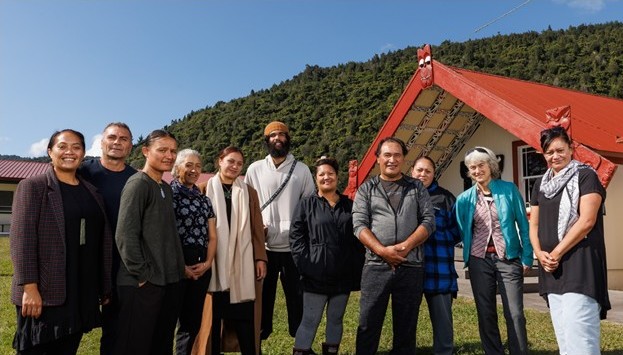New science recruits put myrtle rust in the spotlight
For immediate release
Thursday 21 April 2022
A science-based Jobs for Nature-funded project recently launched at Te Waiiti Marae at Lake Rotoiti in the Bay of Plenty. It is a crucial step in the fight to protect some of New Zealand’s best-known native plants.
The ‘Myrtle Rust Jobs for Resistance’ programme - Te Rātā Whakamaru is a Scion-led project funded by the Department of Conservation - Te Papa Atawhai, which is being delivered in partnership with Rotoiti 15 Trust. The project will allow for the development of knowledge in myrtle rust, working with and for mana whenua in the Bay of Plenty. The programme will have eight full-time equivalent staff working for the next three years in Bay of Plenty forests and science laboratories. They will be monitoring the spread of myrtle rust disease, reporting on tree health and identifying if any trees are resistant to the disease.
Arapeta Tahana from Rotoiti 15 Trust says he and his fellow trustees are committed to providing opportunities for the taiao, culture and people.
“This is logical for us to invest in our own people. To increase capacity for learning for our whenua (land) while protecting our ngahere (forests). This is not the sort of work you can outsource,” Tahana says.
“The goal is to provide jobs and build capability within the Bay of Plenty to protect the ngahere (forest) against myrtle rust,” he explains. “We are committed to not only understanding the impact of myrtle rust within our environment, but to connect and understand our environment better.”
Scion Kāuru co-leader, Mariana Te Rangi told the new work team that many of the things New Zealanders enjoy could disappear if the disease spreads out of control.
“No more pōhutukawa along our coastline and no more feijoas. These species may die out in our lifetime if we do not find ways to protect them,” she says. “The mahi is more important than the forests you are working in – you are working on something that all New Zealanders care about,” she explained.
Te Rātā Whakamaru is unique. Its science focus means that the team will not just be working in the forests, they will also work in Scion’s plant health laboratories. As part of their job, they will be upskilled in several areas of forest biosecurity science.
This partnership is also part of the nationwide ‘Jobs for Nature’ $1.129 billion programme led by the Department of Conservation and the Ministry for Environment to revitalise communities through nature-based employment. Its primary focus is to support businesses to provide employment as the economic impacts of COVID-19 continue to unfold while ensuring environmental benefits.
Myrtle rust arrived in New Zealand in 2017 and has been spreading quickly. It is a particularly damaging fungal disease that can attack more than 30 native species in New Zealand. Pōhutukawa, as well as rātā, manuka, kanuka, ramarama together with feijoa and Eucalyptus are all susceptible to the disease. Death of mature ramarama trees has been recently observed in the East Cape and the disease is escalating in the Bay of Plenty.
Myrtle rust is a wind-borne disease and is impossible to contain.
Scion scientist Heidi Dungey says while this work will not prevent infections, it will help with understanding of when and where the most susceptible myrtle species are within the region and provide ways to support them.
“We can also identify the most resistant trees and work out what helps them stay healthier while others around them may succumb to the disease,” she explained.
Rotorua-based Scion undertakes research for the benefit of New Zealand’s forests. The organisation has significant expertise in the identification of myrtle rust, how it interacts with trees and developing tools to stop its spread. Scion will use its specialist skills to train the group in myrtle rust surveillance, seed collection, setting up and monitoring trials to find as many trees as possible with disease resistance.
[ENDS]

The Jobs for Resistance work team, Te Tira Rātā, together with Scion project co-leads/Kāuru Mariana Te Rangi (left) and Jacqui Bond (second from right) at Te Waiiti Marae
For more information about the Rotorua 15 Trust
Kerri Anne Hancock, General Manager
Rotoiti 15 Trust is one of Aotearoa’s largest Ahu Whenua Trusts, responsible for the care of over 8000ha of ngahere on behalf of over 16,800 whānau who whakapapa to the whenua. Based on and around the shores of Lake Rotoiti in the Bay of Plenty, the Trust is driven by its vision “kia hihiri te ōhanga, te oranga me te pukumahi i runga i te ngākau ngātahi” “Working together to protect and grow the well-being of our people, environment and culture”. https://www.rotoiti15.com
